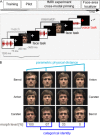How the human brain exchanges information across sensory modalities to recognize other people
- PMID: 25220190
- PMCID: PMC6869110
- DOI: 10.1002/hbm.22631
How the human brain exchanges information across sensory modalities to recognize other people
Abstract
Recognizing the identity of other individuals across different sensory modalities is critical for successful social interaction. In the human brain, face- and voice-sensitive areas are separate, but structurally connected. What kind of information is exchanged between these specialized areas during cross-modal recognition of other individuals is currently unclear. For faces, specific areas are sensitive to identity and to physical properties. It is an open question whether voices activate representations of face identity or physical facial properties in these areas. To address this question, we used functional magnetic resonance imaging in humans and a voice-face priming design. In this design, familiar voices were followed by morphed faces that matched or mismatched with respect to identity or physical properties. The results showed that responses in face-sensitive regions were modulated when face identity or physical properties did not match to the preceding voice. The strength of this mismatch signal depended on the level of certainty the participant had about the voice identity. This suggests that both identity and physical property information was provided by the voice to face areas. The activity and connectivity profiles differed between face-sensitive areas: (i) the occipital face area seemed to receive information about both physical properties and identity, (ii) the fusiform face area seemed to receive identity, and (iii) the anterior temporal lobe seemed to receive predominantly identity information from the voice. We interpret these results within a prediction coding scheme in which both identity and physical property information is used across sensory modalities to recognize individuals.
Keywords: cross-modal priming; face recognition; multisensory; person identity; voice recognition.
© 2014 Wiley Periodicals, Inc.
Figures




References
-
- Adachi I, Kuwahata H, Fujita K (2007): Dogs recall their owner's face upon hearing the owner's voice. Anim Cogn 10:17–21. - PubMed
-
- Andics A, McQueen JM, Petersson KM, Gal V, Rudas G, Vidnyanszky Z (2010): Neural mechanisms for voice recognition. Neuroimage 52:1528–1540. - PubMed
-
- Anzellotti S, Fairhall SL, Caramazza A (2014): Decoding representations of face identity that are tolerant to rotation. Cereb Cortex 24:1988–1995. - PubMed
Publication types
MeSH terms
Substances
LinkOut - more resources
Full Text Sources
Other Literature Sources

